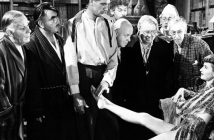
The Man From London (2007)
Cast: Miroslav Krobot, Tilda Swinton, Ági Szirtes
Director: Béla Tarr
Country: Hungary | France | Germany
Genre: Drama
Editor’s Notes: The following review is part of Next Projection Presents Apocalyptic Poetry: The Films of Bela Tarr. Please look out for more of our original series throughout 2015.
Maloin (Miroslav Krobot) is a switchman at the local train depot, but on this night, he’s more interested in a ship in the adjacent harbor than the train that has come in to his station. What at first looks like an attempt to sneak a briefcase into the country turns into a scuffle and then a murder, and Maloin fishes the case, filled with hundreds of 20-pound notes, out of the sea. It’s unclear what Maloin sees in all those bank notes; a rescue of sorts, perhaps, or a chance to right a few wrongs. To his detriment, the one thing that he doesn’t see is the inevitability that someone is going to come looking for that money.
The Man from London (2007) is as bleak and full of existential crises as any other Béla Tarr film, but it still represented quite a departure for the auteur.
The Man from London (2007) is as bleak and full of existential crises as any other Béla Tarr film, but it still represented quite a departure for the auteur. Based on a 1934 novel by popular author Georges Simenon, it was not only a story that had been filmed twice before, but one that lacked much intellectual heft. This straightforward tale of duplicity and murder becomes, in the hands of Tarr and his frequent co-director Ágnes Hranitzky, one man’s choice to descend into the depths of hopelessness and desperation.

Why Maloin chooses to take the money is never clear, though the standard reasons surely apply. The reasons behind his strained relationship with his wife Camélia (a criminally underused Tilda Swinton) and daughter Henriette (Erika Bók) are a cypher, as is anything of his past that might explain his thoughts, his actions, or the few words he chooses to speak.
What distinguishes Maloin from the other silent, indecipherable protagonists of Tarr’s films is what appears to be an almost embarrassing lack of self-awareness, a wholesale refusal to examine his own actions, and an inability to understand even the rudimentary basics of cause-and-effect. He’s not dim, necessarily, but he seems almost allergic to thought. He’s an intellectually and emotionally empty shell in the shape of a human being, and though he seems unhappy with his fate, he seems disinclined to do anything about it himself; one wonders if he long ago left his fate in the hands of the gods.
Echoing the emptiness of Maloin’s existence is the emptiness of the world Tarr has created in The Man from London. The opening may be the typical long, slow pan of a Tarr film, but what we see through the windows of the switchman’s station borrows so heavily from a host of classic noir and old Hollywood films that it looks almost composed from a list of well-known tropes. There’s the romantic gray haze and Victorian street lighting of 1940s American dramas, the sharp dark shadows of mid-cycle noirs, nods to The Maltese Falcon and The Third Man and a half-dozen other films, and a droning score by Mihály Vig that sounds like it could be the Vangelis music from the neo-noir Blade Runner, only slowed down by half.
Béla Tarr’s foray into the genre of noir is a conflicted beast. Noir films rely on heightened emotion, sharp conflicts and solid resolutions, while Tarr’s films rely on nothing of the sort.
Unlike other directors who use such tropes as cultural touchstones or cinematic collage, Tarr’s borrowing so heavily from the noir cycle seems, consciously or not, to highlight an inherent emptiness in the art of cinema itself, an inability to ever truly capture a crisis of the soul. This may have been intentional, or perhaps just a side effect of the film’s overwhelming sense of disorientation. Tarr has all but stripped his filming locations of their identity, creating a series of unconnected locations inhabited by a group of unconnected people. It’s a world so scaled down there is nearly nothing for the audience to hold on to.
It’s a perverse method of control over the audience, on that doesn’t allow them any options other than to just watch. Though overflowing with lengthy single takes and a slow pace — what others have dubbed the “Tarr trudge” — those meditative moments offer no luxury of thought or moment of contemplation. There is no room for what-ifs or worries about what will happen to the characters, because Tarr has made it clear that he has it all mapped out; he controls fate, and your job is to helplessly experience it. But he’s no monster: he’ll give you a chuckle now and again at two excitable furriers, or Henriette’s hilarious timing when it comes to eating soup.
Béla Tarr’s foray into the genre of noir is a conflicted beast. Noir films rely on heightened emotion, sharp conflicts and solid resolutions, while Tarr’s films rely on nothing of the sort. The only substance to the film is in the auteur’s dark questions of existence; everything else, carefully choreographed though it may be, is just so much white noise. The result is a rather thin version of what we’ve come to think of as a Béla Tarr film, still a fine work, but most certainly a lesser work from the Hungarian maestro.
The only substance to the film is in the auteur's dark questions of existence; everything else, carefully choreographed though it may be, is just so much white noise. The result is a rather thin version of what we've come to think of as a Béla Tarr film, still a fine work, but most certainly a lesser work from the Hungarian maestro.



